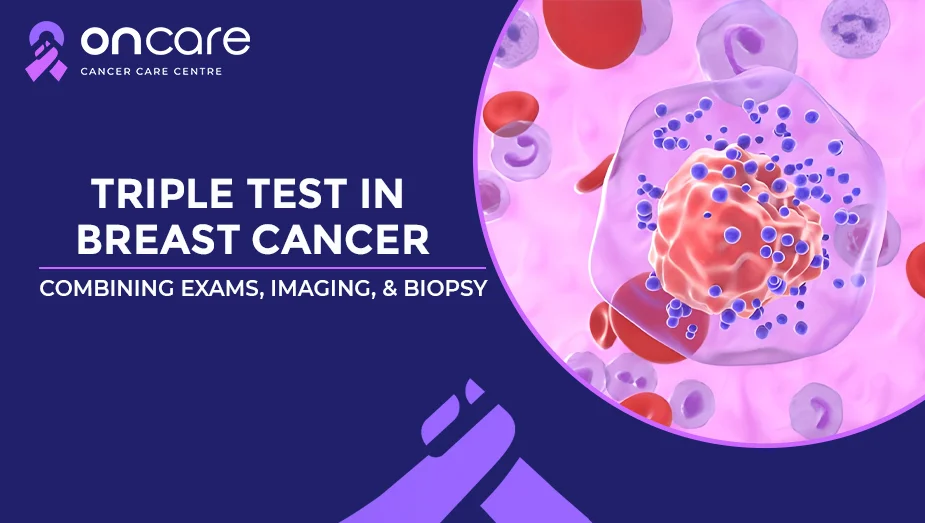Table of Contents
Triple Test in Breast Cancer: Combining Exams, Imaging, and Biopsy

When diagnosing and treating breast cancer, early detection matters a lot! A doctor usually relies on a powerful diagnostic approach known as the ‘triple test for breast cancer.’ This test is known for its combination of three key assessments that work together to provide a precise cancer diagnosis by integrating a clinical examination, imaging tests, and a biopsy. These triple tests help to ensure that there are some breast abnormalities that are deeply examined, reducing the chances of any delayed diagnosis!
In this blog, we’ll discover more about the Triple test for breast cancer and how each component works, and why this Three step approach is considered to be the standard of breast cancer diagnosis!
What is the triple test for breast cancer?
The triple test for breast cancer is a systematic diagnostic method used to evaluate the breast lump or abnormality.
It generally involves three key components, including:
- Clinical breast examination (CBE)
- Imaging (mammography or Ultrasound)
- Biopsy (Tissue sampling for microscopic analysis)
Each step of the triple test for this cancer provides unique and complementary information. When all three components agree, for example, all suggest a benign or a malignant finding in a suspected patient, the accuracy of the approaches will be nearly 100%. However, the accuracy is not often guaranteed to be 100% in every case, while a confirmed result provides a high degree of certainty.
It makes more sense to triple test one of the most reliable and evidence-based diagnostic methods in breast cancer care.
Clinical breast examination
The clinical breast examination is the first step towards the triple test. It’s a physical examination of the breasts performed by a healthcare provider.
What the doctor looks for:
- Lumps or thickened areas in the breast tissue
- Changes in the breast size or shape
- Skin dimpling or puckering
- Changes in the nipple (inversion or discharge)
- Swellings or lumps in the underarm area
A detailed medical history, including the family history and hormonal factors, is also reviewed to assess the cancer risk.
Note:
An imaging and biopsy provide more detailed information; a clinical examination can detect subtle changes and guide which areas need further medical investigation. These also help to identify if the lumps feel suspicious, fixed, or irregular, characteristics often linked with malignancy.
Imaging tests: (Mammography and Ultrasound)
Imaging tests are the essential and second pillar of the triple test, providing the visual evidence of any abnormalities detected throughout the physical examination.
Mammography
A mammogram is a low-dose X-ray performed of the breast.
These are especially found effective in detecting, including:
- Microcalcifications
- Masses or distortions in breast tissue
Mammograms are found to be more sensitive in women over 40, as younger women often have denser breast tissue, which makes the mammogram images harder to interpret.
Ultrasound
An ultrasound tests uses sound waves to create images of the breast and is especially used for,
- Distinguishing between solid masses (possible tumors) and fluid-filled cysts
- Evaluating some abnormalities often found on a mammogram
- Guiding a biopsy needle to the precise area of concern
- Ultrasound is usually preferred in young women or pregnant women, as it doesn’t involve any radiation.
Other imaging modalities may include:
In some cases, doctors also recommend a breast MRI, especially for high-risk patients or unclear findings on other imaging tests.
Biopsy
This is the third and last and most crucial part of the triple test for breast cancer. While a small sample of breast tissue is often removed and examined under a microscope by a pathologist. This step kind of confirms whether the abnormality is benign (non-cancerous) or malignant (cancerous).
Types of breast biopsies
Here are some of the breast biopsies are used for the cancer diagnosis, including:
- Fine needle aspirations cytology (FNAC):
A thin needle is used to collect cells or fluids from the lump. These are quick and minimally invasive but may not provide enough tissue for a complete analysis.
- Core needle biopsy:
A larger needle is often used to remove a small core of tissue, providing more information about the cancer type and grade.
- Surgical biopsy (excision biopsy):
The entire lump or suspicious area is surgically removed. These are typically performed when other biopsy results are indefinite and inconclusive.
Why it matters
The triple test for breast cancer is vital part of modern cancer diagnosis and treatment planning, because it can be useful in many ways, including:
- It helps to reduce the false positives and false negatives
- It helps ensures the accurate, early detection for breast cancer
- It minimizes the need for unnecessary surgeries
- It guides personalised treatment planning
Early detection confirmed through methods like the triple test dramatically improves the survival rates; when breast cancer is caught in the early stages, the five-year survival rate exceeds 90%.
What to expect during the cancer treatments?
Here’s what you can expect during the cancer treatments: a clinical examination, breast imaging, and later a biopsy are performed if any type of abnormality is found in a suspected patient, including:
Clinical Breast Examination & Imaging
Your healthcare team performs a clinical breast examination, followed by a mammogram/ultrasound tests. If any abnormal area is identified during the clinical examination, then a biopsy may be performed immediately or within a few days.
Biopsy appointments:
The biopsy is often performed under a local anesthetic medicine. Patients often experience mild soreness or bruising that might occur forward, but the recovery is quite quick.
Results:
These biopsy results are usually available within 3 to 5 days. Your doctor might explain the results/findings to you and discuss next steps, whether performing observation, surgery, or further cancer treatments.
Frequently Asked Questions
Here are some of the tests used for breast cancer diagnosis, including:
- Clinical examination
- Imaging tests
- Biopsy
Yes, mammograms are a part of a triple test for breast cancer diagnosis and treatment planning. The triple test for breast cancer is a combination of diagnostic tests that are used to evaluate a palpable lump, clinical examination, radiological imaging. These often include mammography or ultrasound, and pathological analysis (biopsy or fine needle aspiration).
Mammograms often use a low dose X-rays to screen for breast cancer, while an ultrasound uses sound waves to create the images of the suspicious patients.

